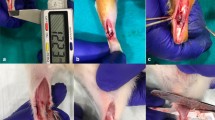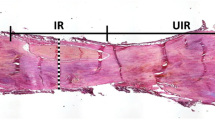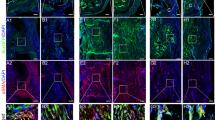Abstract
Introduction
The biomechanics of early tendon healing is important for designing post-injury training, but this has not been described in an animal model, similar to humans in size. We measured elastic and viscoelastic properties of a tendon regenerate in sheep, in a study designed to see the effects of exogenously applying the growth and differentiation factor CDMP-2. This is the first description of early tendon healing in sheep Achilles tendons.
Materials and methods
Twenty female sheep underwent Achilles tendon transection without suturing or immobilization. Two hours after the operation, 100 μg of CDMP-2 or placebo was injected into the hematoma. The sheep were slaughtered after 3 weeks, and tendon regenerates tested for viscoelastic properties by cyclical loading, before a destructive tensile test. Thereafter, all specimens were examined by high resolution computerized tomography (CT), and histology.
Results
The tendon regenerate formed a sleeve, around the tendon stumps. Failure occurred between the regenerate sleeve and the tendon stumps. There was an unexpectedly large variation in force at failure. In the CDMP-2 group, force correlated with regenerate transverse area, but not in the controls. Thus, the variation in maximum stress was smaller in the CDMP-2 group (P = 0.009). Although the force at failure was only a tenth of normal, the capacity to store elastic energy was already near normal (hysteresis 16%). The mean transverse area, force at failure and stiffness were all about 30% larger in the CDMP-2 group, but this was not significant. There were no signs of bone or cartilage formation on CT or histology.
Conclusions
Results are compatible with a positive effect of CDMP-2, but the power was too low to demonstrate any such effect. Considering that spontaneous ruptures in humans are likely to have a more variable geometry than in this model, humans can also be expected to vary a lot in early mechanical characteristics. This emphasizes the importance of individualized rehabilitation programs. The low hysteresis suggests that the energy storing capacity is rather easy for the tissues to develop; possibly it is harder to create appropriate energy dissipation, in order to avoid re-rupture.


Similar content being viewed by others
References
Bruns J, Kampen J, Kahrs J, Plitz W (2000) Achilles tendon rupture: experimental results on spontaneous repair in a sheep-model. Knee Surg Sports Traumatol Arthrosc 8:364–369
Eliasson P, Fahlgren A, Pasternak B, Aspenberg P (2007) Unloaded rat Achilles tendons continue to grow, but lose viscoelasticity. J Appl Physiol 103:459–63
Finni T, Komi PV, Lepola V (2000) In vivo human triceps surae and quadriceps femoris muscle function in a squat jump and counter movement jump. Eur J Appl Physiol 83:416–426
Forslund C, Aspenberg P (2003) Improved healing of transected rabbit Achilles tendon after a single injection of cartilage-derived morphogenetic protein-2. Am J Sports Med 31:555–559
Forslund C, Rueger D, Aspenberg P (2003) A comparative dose-response study of cartilage-derived morphogenetic protein (CDMP)-1, -2 and -3 for tendon healing in rats. J Orthop Res 21:617–621
Kubo K, Kawakami Y, Fukunaga T (1999) Influence of elastic properties of tendon structures on jump performance in humans. J Appl Physiol 87:2090–2096
Pollock CM, Shadwick RE (1994) Allometry of muscle, tendon, and elastic energy storage capacity in mammals. Am J Physiol 266:R1022–R1031
Pollock CM, Shadwick RE (1994) Relationship between body mass and biomechanical properties of limb tendons in adult mammals. Am J Physiol 266:R1016–R1021
Spurrs RW, Murphy AJ, Watsford ML (2003) The effect of plyometric training on distance running performance. Eur J Appl Physiol 89:1–7
Acknowledgments
Bo Skoog made the mechanical testing. Staffan Hammerby analyzed CT. This study was supported by the Swedish National Centre for Sports Research, “Materials in Medicine”, Linkoping, Sweden, and the Swedish Research Council, project 2031.
Author information
Authors and Affiliations
Corresponding author
Rights and permissions
About this article
Cite this article
Virchenko, O., Fahlgren, A., Rundgren, M. et al. Early Achilles tendon healing in sheep. Arch Orthop Trauma Surg 128, 1001–1006 (2008). https://doi.org/10.1007/s00402-008-0691-x
Received:
Accepted:
Published:
Issue Date:
DOI: https://doi.org/10.1007/s00402-008-0691-x




